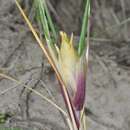en
names in breadcrumbs


The species attacking fruit-infesting tephritids have generally been characterized as polyphagous. Caution should also be exercised when attempting to determine hosts of Eurytoma since some species are known to be phytophagous.
Both Eurytoma oleae Silvestri and Sycophila aethiopica (Silvestri) have been reared from cultivated olives in South Africa (Neuenschwander 1982). Both Silvestri (1915) and Neuenschwander (1982) noted that Eurytoma oleae developed on the seeds of olives and is thus phytophagous. Sycophila aethiopica, on the other hand, is most likely to be a parasitoid of seed-infesting chalcidoids, as is Eurytoma varicolor Silvestri (Silvestri 1915).
Members of the genus Eurytoma are exceptionally difficult to identify to species, but the family can be readily recognized by the quadrate, usually deeply pitted pronotum (Fig. 1) and general habitus (Fig. 2).
The Eurytomidae are a family within the superfamily Chalcidoidea.
Unlike most chalcidoids, the larvae of many are phytophagous (feeding in stems, seeds, or galls), while others are more typical parasitoids, though even then the hosts are usually found within plant tissues. They are found throughout the world in virtually all habitats, and a few are considered pests.
They tend to be dull and not metallic, and heavily punctured, with very thick, collar-like pronota.
As of 2021, Eurytomid genera include:[1]
Buresiinae Lotfalizadeh et al, 2007[2]
Eurytominae Walker, 1832
Heimbrinae Burks, 1971
Rileyinae Ashmead, 1904
The Eurytomidae are a family within the superfamily Chalcidoidea.
Unlike most chalcidoids, the larvae of many are phytophagous (feeding in stems, seeds, or galls), while others are more typical parasitoids, though even then the hosts are usually found within plant tissues. They are found throughout the world in virtually all habitats, and a few are considered pests.
They tend to be dull and not metallic, and heavily punctured, with very thick, collar-like pronota.